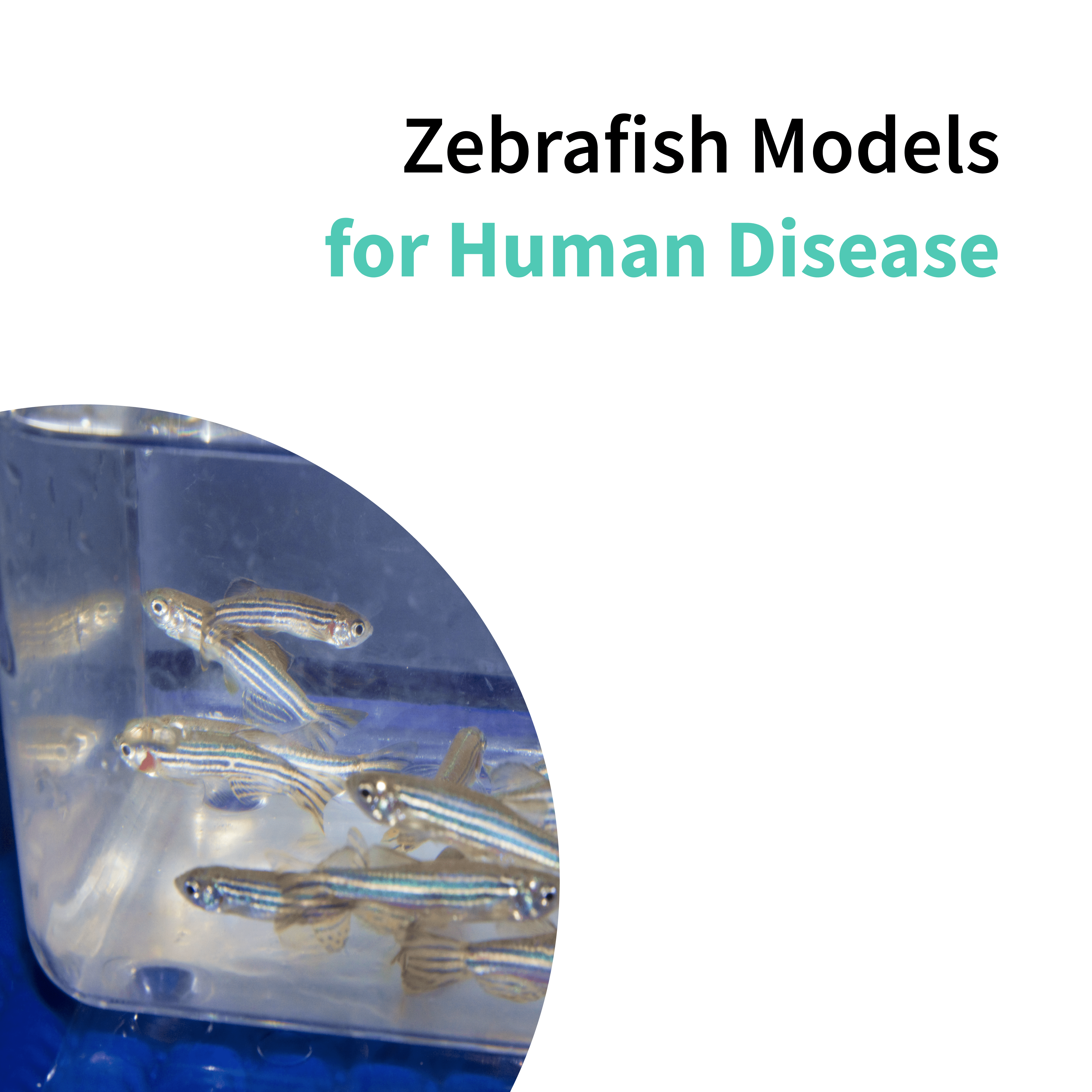Zebrafish model for human disease
Genome editing technologies have revolutionized biomedical research, enabling precise genetic material manipulation to study gene functions and their roles in disease pathogenesis. Techniques such as Zinc Finger Mutations and Tol2 transposon systems have given the possibility to create animal models of human diseases with remarkable accuracy.
Among various human disease models, Zebrafish has emerged as a powerful and versatile system. It is a valuable model organism for the study of vertebrate biology, being well-suited to both developmental and genetic analysis. Large-scale genetic screens have identified hundreds of mutant phenotypes, many resembling human clinical disorders. Zebrafish disease models offer several advantages, first of all, their genetic similarity to humans and the ease of genetic manipulation.
Their use in this research field is driven by the necessity for effective models that can accurately mimic human disease processes and provide valuable insights into their genetic and molecular mechanisms. This article delves into the application of Zebrafish as models for human diseases, highlighting their impact on biomedical research.
The use of Zebrafish (Danio Rerio) as biomedical models
The use of Zebrafish as human disease models relies on their unique biological and genetic characteristics. Zebrafish share approximately 70% of their genes with humans, and more than 80% of their genes are orthologues of those implicated in human diseases. This genetic similarity makes them an ideal model for gaining insights directly translatable to human health, both for disease and novel drug efficacy studies.
Zebrafish embryos are transparent and develop externally, allowing for phenotypical screening of the developmental processes and cellular behaviors. This transparency is particularly advantageous for studying organogenesis and the effects of genetic modifications in real time. The development of major organs, including the heart, brain, and blood vessels, can be observed and studied within the first few days post-fertilization.
Zebrafish are also cost-effective and easy to maintain compared to traditional mammalian models. Their small size and high fecundity rate allow for high-density housing and large-scale genetic and High Content Screening studies. The short generation time of Zebrafish, approximately three months, accelerates genetic studies and the analysis of inherited traits. The effects of genetic modifications across multiple generations can be rapidly assessed, providing valuable data on gene function and inheritance patterns.
Zebrafish are highly responsive to genetic manipulation. The development of advanced genetic tools, such as mRNA injections for impression of HA-tagged proteins and Transcription Activator like Effector Nucleases, has revolutionized the possibilities of editing the Zebrafish genome with high precision. These technologies enable the possibility of containing a specific gene by encoding a complete and functional transposase that can identify and reinsert the DNA material, introduce targeted mutations, and study resulting phenotypic effects, thereby mimicking human genetic disorders.
Beyond disease modeling, Zebrafish genetic manipulation has greatly enhanced our understanding of basic gene function, allowing us to study specific genes' roles in development, physiology, and behavior. This knowledge is critical for understanding how genetic variations contribute to health and disease, making Zebrafish a highly valuable tool beyond just serving as a human disease model.
Zebrafish disease model for humans
The versatility of Zebrafish as a model organism has led to the development of numerous Zebrafish disease models that closely mimic human pathologies. These models have been instrumental in elucidating the disease's molecular mechanisms and identifying potential therapeutic targets.
Zebrafish disease models have been widely used to study various types of cancer, including melanoma, leukemia, and pancreatic cancer. Zebrafish disease models that recapitulate key features of human cancers have been created by manipulating genes involved in tumorigenesis or by introducing human oncogenes in the Zebrafish genome. Zebrafish cancer models are also used for High-Content Screening to identify promising anti-tumoral compounds.
Biobide develops Zebrafish disease models for pre-clinical Drug Discovery and Development, such as in the target identification stage. As a Contract Research Organization (CRO) company offering drug discovery services to Pharma and Biotech companies, Biobide can offer highly efficient tailor-made assays for human disease study. Through different techniques such as genetic mutations, transgenic-induced gene alterations, or drug-induced metabolic alterations, Biobide can generate transgenic or mutant Zebrafish models of several diseases.
The Zebrafish nervous system shares many similarities with the human one, making it a suitable model for studying neurological disorders. Biobide has a wide range of services in the Zebrafish models of rare neurodegenerative/neuromuscular diseases for target validation and potential drug screenings, such as:
-
Parkinson's Disease
-
Alzheimer's Disease
-
Epilepsy
-
Duchenne muscular dystrophy (DMD)
-
Dravet Syndrome (DS)
Sources
Cassar S, Adatto I, Freeman JL, Gamse JT, Iturria I, Lawrence C, et al. Use of Zebrafish in Drug Discovery Toxicology. Chem Res Toxicol. 2020;33(1):95-118.
Howe K, Clark MD, Torroja CF, Torrance J, Berthelot C, Muffato M, et al. The zebrafish reference genome sequence and its relationship to the human genome. Nature. 2013;496(7446):498-503.
Dash SN, Patnaik L. Flight for fish in drug discovery: a review of zebrafish-based screening of molecules. Biology Letters. 2023;19(8):20220541.
Dooley K, Zon LI. Zebrafish: a model system for the study of human disease. Curr Opin Genet Dev. 2000;10(3):252-6.
Ward AC, Lieschke GJ. The zebrafish as a model system for human disease. Front Biosci. 2002;7:d827-833.




